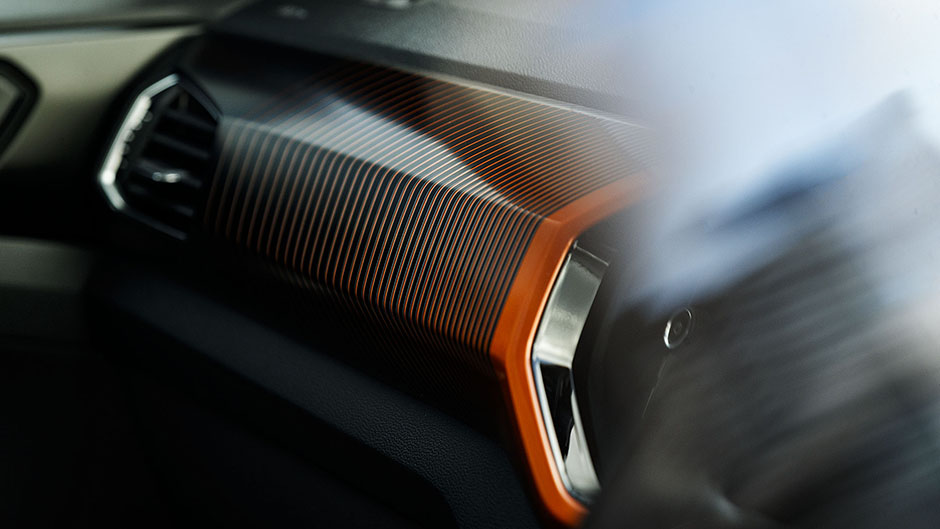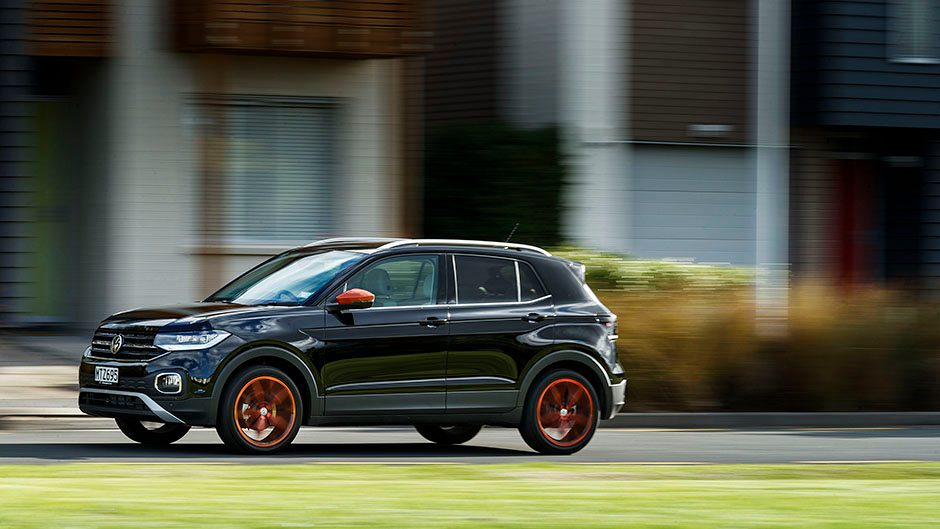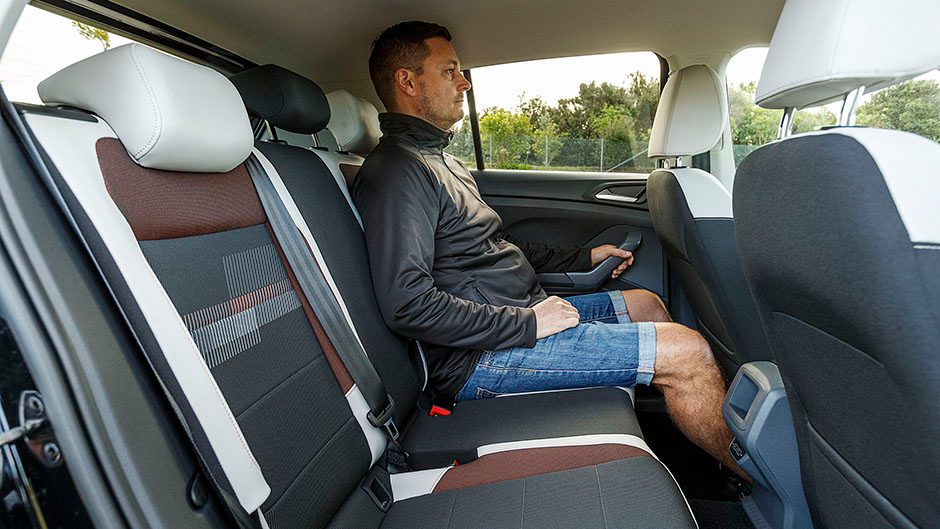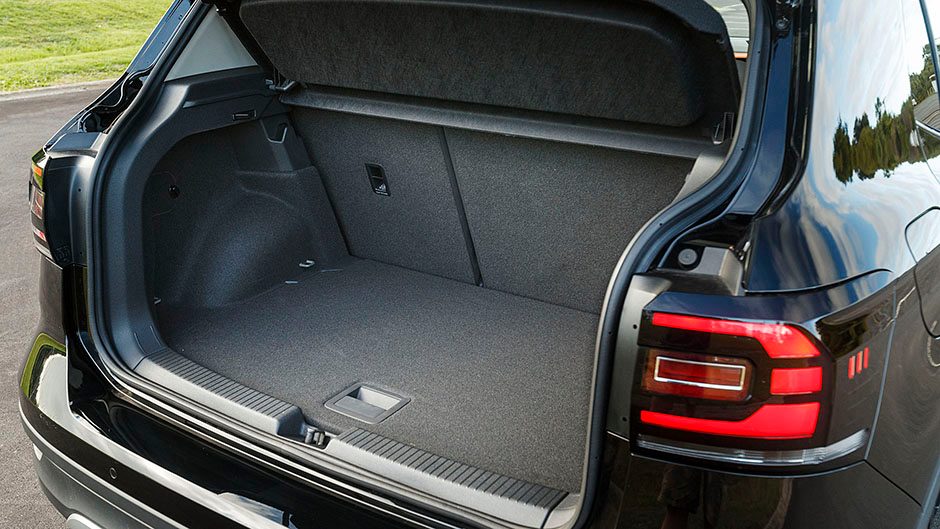Just how far have cars fallen out of favour in the NZ market place? If you peruse the VW range available here, it seems the demise has been substantial. The only ‘cars’ in the line-up are the Polo and the Golf. All the rest are high riding contraptions or commercials. The latest ‘hot wee thing’ in range is the T-Cross, VW’s smallest SUV offering to date.
It’s based on the Polo, and goes down the same line as the small hatch in a factory in Spain. They call it an urban crossover thanks to its upright stance and that plastic around the lower extremities and wheel arches. It’s only fractionally longer than the Polo (by 54mm) at 4108mm overall but taller by 112mm at 1584mm. And if you need to know, it’s 120mm shorter than the next-size-up T-Roc (which is still ‘coming soon’).
The local line-up has four offerings kicking off with the ‘Life’ at $34,240, which is $500 more than the Polo R-line. Next up is the Style ($38,490) while we have the 1st Edition at $39,990, which is essentially a styling pack with the inclusion of a big Beats stereo system. Topping the range initially at least is the R-Line at $43,490. This alone gets the 110kW 1.5-litre four cylinder. The rest use a 1.0-litre triple making 85kW, with 200Nm chiming in from 2000-3500rpm. All come rigged to a seven-speed twin-clutch auto and drive the front wheels only.

T-Cross has a passing resemblance to the rest of the SUV range, and is not merely a jacked-up hatch like the old Cross Polo. It’s fairly conservtive in a boxy, practical manner, so if you think the Juke still looks weird, you’ll probably like this. Judging by the amount of people giving it a second glance in the car park, it seems VW is on to a winner in a design sense, at least.
It has the usual elevated seating posi that people like, being 100mm higher than the Polo. And so if your hip flexion is not what it used to be, it is easy to climb on board.
The cabin looks pretty swish but is light on soft touch points, the abundant hard and grey plastic giving away its Polo origins. VW is probably hoping the tech infusion will avert your attention with a wireless charge pad at the base of the centre stack, and a comprehensive infotainment system, complete with inbuilt nav and digital dials allowing a raft of customisable views. A new multifunction steering wheel makes for simplified control of the gizmos. Things like the (overly) active lane keeping system are easily disabled, and it looks like setting active cruise will be easier with its new button layout, relegating the old cruise wand to history. Active cruise, by the way, is only available on the top model and isn’t even an option for the Style. In fact, there are no options for the T-Cross range whatsoever.

Funky detailing seems to be mandatory for the urban crossovers and T-Cross sports a vibrant cabin decor, seen here with the orange highlights on the dash and centre stack surround. Along with the usual white, silver, grey and black, there are a few lively exterior tones too.
While the buttons and knobs for the ventilation system look a little dated, they are cunningly easy to use; no double taps and swipes required to simply crank up the temperature. The cabin storage spots are pokey, though there are a few extras about, like the drawers under the seats. None of the cubbies is lined like they used to be in VW products, and another concession to cost is the starter button that remains on the left side of the gear lever. T-Cross even lacks grab handles above the door. But adding all that active safety gear means extra cost, so we guess there have to be sacrifices. There’s still a manual handbrake too meaning the cup holders are smaller than desirable. Unusually, the front passenger seat has Isofix hooks and a top tether for a child’s seat. It’s easy to turn the front airbag off if you’re wondering. There are further Isofix points in the rear, while the bench itself is on sliders, with 140mm of travel to vary the amount of legroom or luggage space you may require. The rear is easy to access with generous-sized doors, the seats here set slightly higher than those up front. Though a ‘small SUV’ there’s more room back here than in the Polo, and the accommodations are comfy. Its boot is a reasonable size, not class leading, especially with the Beats subwoofer taking up vital space under the floor. But with the sliding seat, VW can claim up to 455L of space, though 385L, with the rear seat back in its usual place, is more representative of the norm. The split folding procedure is straightforward and there’s room for a full-size spare under the floor.
As with any good city car, it’s a snip to drive. There’s a sorted driving position, good outward vision, the mirrors are decent and backed by blind spot monitoring. The slight obstruction caused by the C pillar is alleviated by the wide angle view from the reverse camera on the vibrant screen. Another of its features is a self-parking function, but why you’d need it on something this size is a mystery, the steering light, and the turning circle sharp.

The 1.0-litre T-Cross is rated at 5.4L/100km overall, though the long term average over 1443km was sitting at 7.9L/100km. We managed 7.6L/100km overall, while a busy day spent cruising the motorway back and forth netted an average in the low fives. The turbo needs 95 octane however.
Typical of most VW vehicles, the twin-clutch changes up quickly through the gears, milking the torque of the boosted engine, and is reluctant to change down unless you give the gas a genuine prod. Even though it’s a wee litre, there’s enough urge from idle and it pulls remarkably well from 2000rpm. Despite it having seven gears, 100km/h in top equates to just over 2000rpm. Don’t expect it to go for broke from a standstill either, for it’s lethargic out of the blocks, and takes over 10 seconds to hit 100. But the only real issue is the idle-stop system; it’s just too slow to refire. The around-town ride quality gets a pass mark, even if there’s some road noise permeating the cabin.
The T-Cross has a bit of spunk to its progress out of town though. The steering is relatively quick, accurate, and the weighting about right too. There’s even a modicum of sensation to help keep it on track. The tyres make more noise than they should but then the T-Cross doesn’t surrender easily to understeer. It’s a lively handler, flowing nicely from corner to corner and is not too rolly polly, though the ride can be tested on bumpy tracks, the torsion beam rear reaching its limitations. The little three-pot doesn’t stress the chassis or the traction control and beavers away willingly, though is well done by 6000rpm. Its twin-clutch in the Sport mode makes the most of those 200Nm while frequently tapping the power, holding on to the redline when urged on.

Among the features is VW’s new five-year, 150,000km cover, enough to warrant a little sticker on the front screen. Other bits include a smart key, dual zone air, LED headlights, privacy glass and ambient lighting, helping to justify the $40k price tag.
The T-Cross has plenty of rivals. Buy it because you want something genuinely compact, but still reasonably practical and smartly styled. You appreciate in-car tech too and want something easy to drive. If you want more space and power for a similar outlay, check out the Skoda Kamiq.
| Model | Volkswagen T-Cross TSI 1st Edition | Price | $39,990 |
| Engine | 999cc, IL3, T/DI, 85kW/200Nm | Drivetrain | 7-speed twin-clutch, front-wheel drive |
| Fuel Use | 5.4L/100km | C02 Output | Xg/km |
| 0-100km/h | 10.51sec | Weight | 1288kg |


